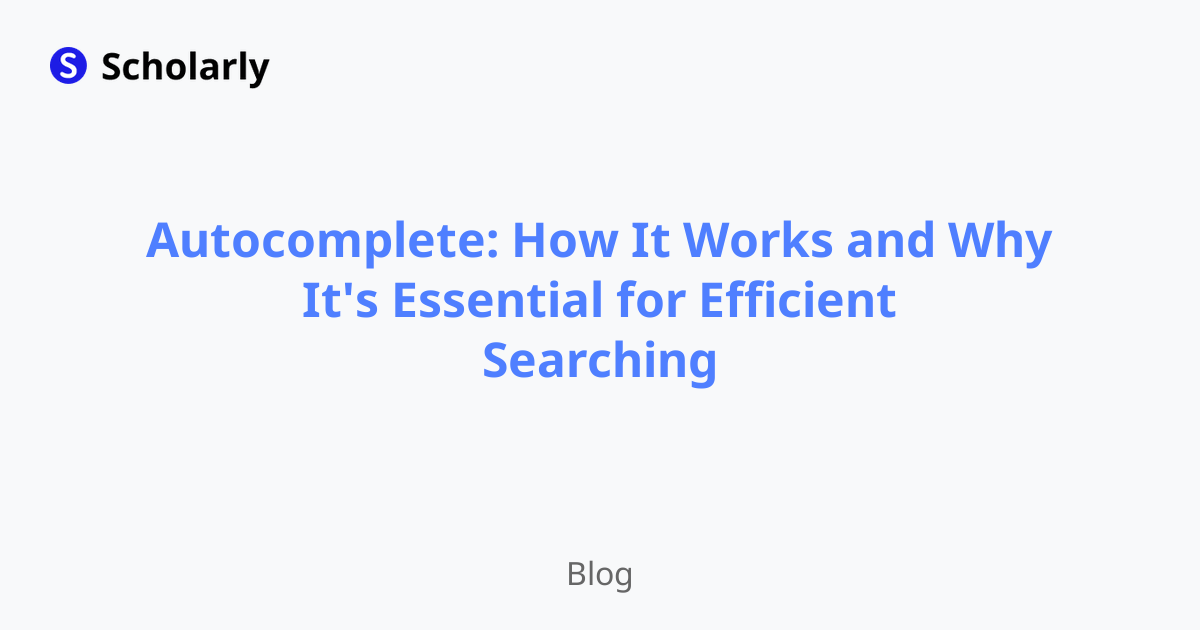Autocomplete: How It Works and Why It's Essential for Efficient Searching
Discover the inner workings of autocomplete and its importance in enhancing search efficiency. Learn about the technology behind it, its benefits, and best practices for implementing autocomplete in various applications.

Introduction
In today's digital age, search engines have become an indispensable tool for finding information. As you start typing a query, you may have noticed that search engines often provide suggestions to complete your search query. This feature is called autocomplete, and it plays a crucial role in enhancing search efficiency. In this article, we will explore the inner workings of autocomplete, its importance, and best practices for implementing it in various applications.
History
Before we dive into the inner workings of autocomplete, let's take a brief look at its history. Autocomplete technology has been around for several years, and it has evolved significantly over time. Initially, autocomplete was primarily used for suggesting previously typed phrases to save users time and effort. However, with advancements in artificial intelligence (AI) and machine learning, autocomplete has become more intelligent and efficient.
Current State
In the current state, autocomplete utilizes a combination of algorithms and user behavior data to generate intelligent suggestions as users type. These algorithms take into account several factors, such as the frequency and popularity of search queries, the user's location and preferences, and the context of the search to provide relevant and personalized suggestions. As a result, autocomplete not only saves time for users but also helps them discover new and relevant content.
How Autocomplete Works
Autocomplete works by analyzing user input and generating suggestions based on a variety of data sources. Here's a simplified breakdown of the process:
- User Input - As users start typing a search query, the autocomplete system analyzes the input character by character.
- Query Analysis - The system analyzes the query to identify patterns and keywords that can help generate relevant suggestions.
- Data Retrieval - Autocomplete retrieves data from various sources, such as search logs, website content, and user preferences, to generate suggestions.
- Ranking - The suggestions are ranked based on factors like relevance, popularity, and user behavior patterns.
- Display - The top suggestions are displayed in real-time as the user types, providing a seamless and efficient search experience.
Benefits of Autocomplete
Implementing autocomplete in search engines and other applications offers several benefits:
- Time-Saving - Autocomplete significantly reduces the time it takes to formulate a search query, allowing users to find information more quickly.
- Reduced Errors - By suggesting relevant queries, autocomplete helps prevent spelling errors and provides more accurate search results.
- Improved User Experience - Autocomplete enhances user experience by providing real-time suggestions that can guide users in formulating their query and discovering new content.
- Increased Engagement - With autocomplete, users are more likely to explore additional search suggestions, leading to increased engagement and time spent on the platform.
- Personalization - Autocomplete leverages user behavior data to provide personalized suggestions, improving the relevance and accuracy of search results.
Best Practices for Implementing Autocomplete
To optimize the effectiveness of autocomplete in your applications, consider the following best practices:
- Responsive Design - Ensure that your autocomplete feature is responsive and works seamlessly across different devices and screen sizes.
- Real-Time Suggestions - Provide real-time suggestions that update dynamically as users type, offering a smoother and more efficient search experience.
- User Privacy - Implement appropriate data privacy measures to protect user information and ensure compliance with data protection regulations.
- Filtering and Ranking - Use algorithms to filter and rank suggestions based on factors like relevance, user preferences, and popularity.
- Contextual Suggestions - Take into account the context of the search and any available user data to generate more personalized and relevant suggestions.
Conclusion
Autocomplete has revolutionized the way we search for information, making the process faster, more efficient, and personalized. By understanding how autocomplete works and implementing it using best practices, you can enhance the search experience for your users and help them discover the information they need with ease. Embracing autocomplete in search engines and other applications is crucial for staying ahead in the digital landscape and providing a seamless user experience.
Implement autocomplete in your own applications with the help of Scholarly, an AI-powered platform that offers advanced autocomplete features, making search more efficient and accurate. Sign up for Scholarly today and optimize your search experience!
Try Our Popular AI Study Tools
Transform your study materials into interactive learning experiences with our most popular AI-powered tools:
PDF to Flashcards
Convert lecture notes and textbooks into study flashcards instantly
Text to Flashcards
Turn any text or notes into comprehensive flashcard sets
Image to Flashcards
Convert diagrams and handwritten notes into digital flashcards
YouTube to Flashcards
Generate flashcards from educational video content



